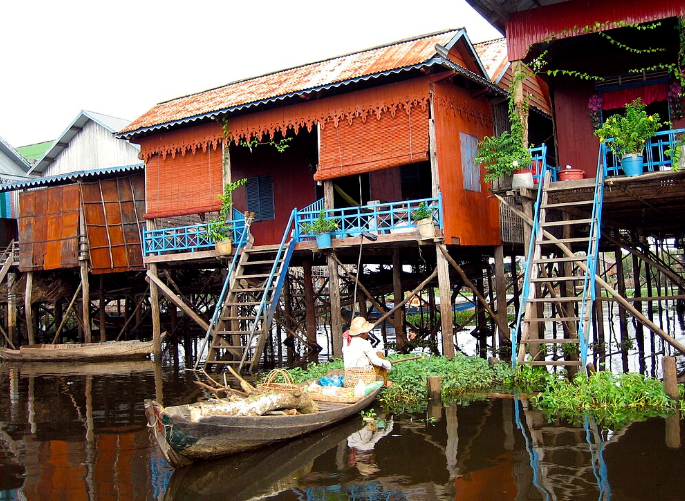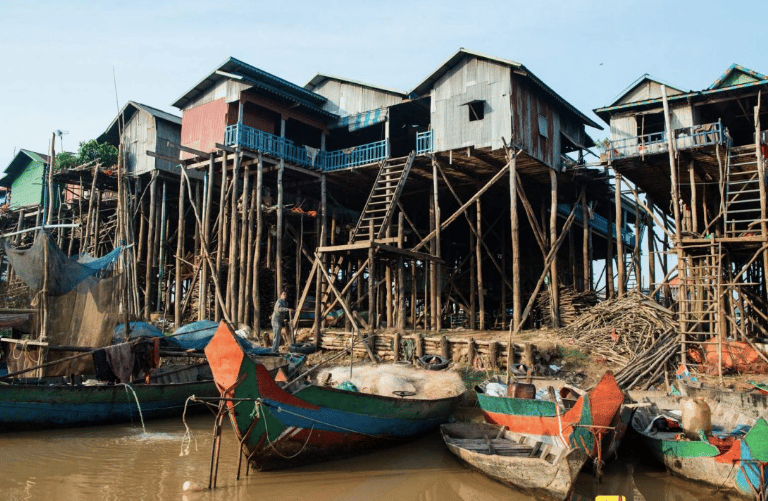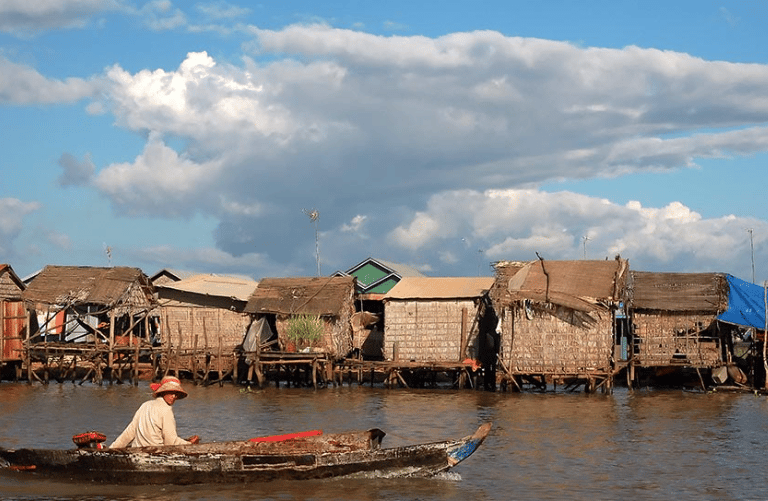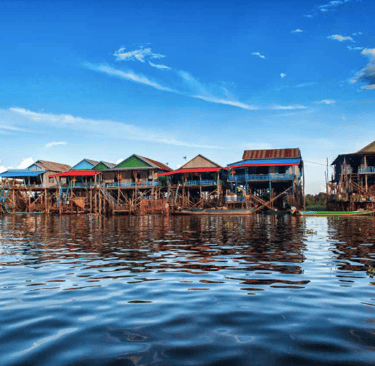Floating Villages of Tonlé Sap: Traditions and Ecological Threats
Discover the floating villages of Tonlé Sap in Cambodia — a unique way of life shaped by ancient traditions and challenged by the growing impacts of tourism and climate change.
BLOG CAMBODIA
11/1/202512 min read


The Floating Villages of Tonlé Sap: Between Traditions and Ecological Threats
In the heart of Cambodia stretches an immense lake—almost an inland sea—whose appearance shifts with the rhythm of the seasons. Tonlé Sap, the true lung of the country, has shaped for centuries the lives of thousands of families who have built their floating villages upon its waters. Here, everything seems in motion: houses drift with the current, markets sway with the wind, and children paddle to school as others might walk to the playground. These communities, at once isolated and deeply connected to their surroundings, embody a way of life intimately tied to nature.
Around Kampong Phluk, Kampong Khleang, Mechrey, and Chong Khneas, visitors discover a world where land and water merge into one. Fishing, navigation, and trade structure the daily lives of inhabitants who have learned to adapt to the rise and fall of Southeast Asia’s largest lake. Yet behind this picturesque image lies a more fragile reality. Rising temperatures, overfishing, deforestation, and the growth of mass tourism are disrupting a centuries-old balance.
Tonlé Sap is not merely a lake—it is a living memory of Cambodia, a mirror reflecting the social and environmental changes transforming the entire region. Each season, it gives and takes, feeding millions while exposing the precariousness of a life suspended upon its surface.
This feature invites readers to dive into the heart of these floating villages, to understand how traditions endure in the face of ecological threats. Behind the fishing nets and wooden planks lie stories of resilience, transmission, and survival. From the quiet of misty mornings to the bustle of aquatic markets, the inhabitants of Tonlé Sap offer both a lesson in adaptation and a warning about the disruptions reshaping their world. This journey—between tradition and modernity, between beauty and vulnerability—offers a new way to see Cambodia, through the shimmering reflections of its sacred lake.
1. An Ancestral Way of Life Shaped by Water
1.1. A Life Suspended Between Sky and Lake
For generations, life on Tonlé Sap has followed the rhythm of the waters. When the monsoon swells the Mekong, the lake expands, flooding the plains and multiplying its surface fivefold. When the dry season returns, the waters retreat, revealing muddy stretches where stilt houses seem to hover above the void. Between these two worlds, the inhabitants of Tonlé Sap have learned to build a way of life marked by rare adaptability. Their wooden houses, often painted in bright colors, rest on barrels or woven bamboo, allowing them to rise and fall with the lake’s level without ever anchoring to the ground.
Each village floats in its own way. In Kampong Khleang, houses rise on towering stilts, forming a sort of aerial labyrinth. Further south, in Chong Khneas, homes sit directly on the water, linked by fragile walkways. There, people live by the rhythm of the wind, the waves, and the comings and goings of small boats. Fishing remains the main source of income, yet the balance between tradition and modernity is increasingly unstable. Engines replace oars, satellite dishes sprout from rooftops, and children grow up navigating between two worlds—the one of their ancestors and another, more uncertain, yet to come.
1.2. Fishing, the Living Memory of a People
The lake sustains an entire nation. At dawn, hundreds of canoes glide out of the villages, disappearing into the mist to retrieve the nets set overnight. The catch changes with the season—catfish, tilapia, shrimp, even freshwater snakes. Fishing is more than an occupation; it is an identity, an inheritance passed from father to son, mother to daughter. Around Tonlé Sap, the gestures have changed little over the centuries: the hand that casts the net, the eye that reads the current, the silence before dawn.
Yet this tradition is faltering. The lake’s resources are dwindling under the strain of overfishing and changes in the Mekong’s flow. Elders recall a time when fish were so abundant that they could feed entire villages. Today, fishermen must venture farther, often uncertain they’ll return with enough to live on. In this fragile context, solidarity between families has become vital. The floating markets are more than economic hubs—they are spaces for sharing, news, and collective survival. On Tonlé Sap, every fish sold tells a small part of a people’s story, one who continues to fight to keep their lives intertwined with their lake.
2. Villages in Rhythm with the Seasons
2.1. The Lake’s Transformation
Tonlé Sap is never the same twice. Its “breathing” follows the monsoon: when rains swell the Mekong, the current reverses, and water rushes into the lake, flooding surrounding forests and rice fields. This spectacular rise transforms the landscape and reshapes life. Houses, once perched on muddy banks, begin to float. Schools, markets, and pagodas rise with the lake’s level, as if the entire village were gliding gently on water. During the dry season, the movement reverses. The lake retreats, canals narrow, and boats must sometimes be dragged several meters across the mud to reach the current.
At Kampong Phluk, this seasonal transformation is particularly striking. During the monsoon months, streets become waterways. Children paddle to school, dogs sleep on the walkways, and fishermen climb onto roofs to watch over their nets. Then, when the dry season comes, the same houses are suspended several meters above the ground, their towering stilts exposed by the receding waters. This alternation between abundance and withdrawal shapes not only the landscape but also the mindset of the inhabitants: living on Tonlé Sap means accepting change as a constant, never considering oneself an owner of a place, but merely a guest sharing it with nature.
2.2. Dependence on Nature and Human Vulnerabilities
This intimate relationship between inhabitants and their environment is both a strength and a vulnerability. Tonlé Sap nourishes, protects, and transports, but it can also threaten. More violent floods, unpredictable water levels, and extreme climate variations now disrupt this centuries-old cycle. In Mechrey, some residents recount how late floods destroyed floating crops or swept away fishing nets. Others speak of the dwindling fish population and the growing difficulty of supporting their families.
What was once a predictable seasonal rhythm has become a source of concern. Younger generations, drawn to the cities, gradually leave the floating villages, leaving behind an aging population. Yet, despite these uncertainties, life continues on the lake. Each season brings hope: the first rains as a promise, the return of fish as a sign of renewal. It is this fragile balance, both poetic and precarious, that makes Tonlé Sap a unique world, where time is measured not in days, but in cycles of water and light.
3. The Impacts of Tourism on Tonlé Sap
3.1. The Rise of a Double-Edged Tourism
Over the past fifteen years, the floating villages of Tonlé Sap have become one of the most popular excursions from Siem Reap. Visitors, fascinated by this timeless way of life, board motorized canoes to explore Kampong Phluk, Mechrey, or Chong Khneas. Tours multiply, promising “authentic encounters” and “journeys into traditional Cambodia.” For many local families, this influx of visitors represents a new source of income: selling handicrafts, running restaurants, and guiding excursions. Tourism has enabled some villages to fund schools, improve living conditions, or diversify economic activities.
However, this windfall remains fragile and unevenly distributed. In Chong Khneas, often criticized for commercial excesses, much of the profit bypasses the residents, captured by intermediaries or outside businesses. The constant movement of tourist boats disrupts the lake’s tranquility, creates noise, and damages the banks. Engines pollute the water, already stressed by fishing and domestic waste. Behind the smiles and picturesque scenery, Tonlé Sap suffers from visitor numbers that sometimes exceed its capacity.
3.2. The Emergence of More Responsible Tourism
In response to these issues, local initiatives are promoting tourism that respects the lake and its inhabitants. In Mechrey, for example, a community-led project offers rowing boat tours that reduce noise pollution and foster direct contact with locals. Visitors experience daily life, traditional fishing techniques, and the ecological richness of the lake without disturbing its balance. Other programs encourage plastic reduction, guide awareness, and the promotion of local handicrafts rather than imported souvenirs.
This slow but tangible evolution reflects growing awareness: Tonlé Sap cannot be reduced to a living postcard. Preserving its authenticity is essential for the survival of the communities that inhabit it. For tourism to become a driver of development rather than a source of destruction, it must respect the lake’s rhythm, its people, and its heritage. Between economic promise and ecological threat, Tonlé Sap is still seeking the right balance for sustainable coexistence.
4. Biodiversity Threatened by Environmental Changes
4.1. A Vital Ecosystem for All of Cambodia
Tonlé Sap is more than just a lake: it is an ecosystem of exceptional richness, designated a UNESCO Biosphere Reserve. It is home to over 300 fish species, dozens of migratory bird species, and a unique flora adapted to seasonal flooding. The flooded forests along its shores serve as breeding grounds for a large portion of the Mekong’s aquatic wildlife. Every year, when the waters rise, these forests become a vast sanctuary where life emerges in suspended silence. The lake’s inhabitants, whether fishermen or floating farmers, depend directly on this biodiversity for their survival. Even slight variations in the natural cycle affect catches, harvests, and, by extension, the economic stability of the entire country.
Yet this millennia-old balance is gradually eroding. Dams constructed upstream on the Mekong disrupt the natural water flow, reducing the lake’s fertility and altering fish migration. Human activities, deforestation along the banks, and growing pollution accelerate the degradation of an already fragile ecosystem. In Kampong Khleang, some residents speak of water that was once clear now turned murky, fish stocks that have disappeared, and entire flooded forest areas that no longer regenerate. What once made Tonlé Sap rich—its ability to renew itself—now seems threatened by resource depletion and collective indifference.
4.2. The Consequences of Climate Change
Climate change amplifies these imbalances. Seasons are becoming unpredictable, rainfall more intense, and droughts longer. Rising temperatures increase evaporation and promote algae growth, which depletes oxygen in the water. In some years, the lake’s level falls to a critical point, affecting not only fishing but also navigation and access to drinking water. Residents must adapt quickly: relocating homes, digging new canals, or abandoning areas that have become too unstable.
The degradation of Tonlé Sap’s biodiversity is not limited to Cambodia; it concerns all of Southeast Asia. This lake, the beating heart of the Mekong basin, partially regulates regional climate and the food security of millions of people. Its fragility reflects a broader imbalance between human societies and natural cycles. Behind the serene landscapes of Tonlé Sap lies an entire world in flux, a reminder that the beauty of these floating villages depends on a balance now under threat.
5. Between Tradition and the Future: The Resilience of Tonlé Sap’s Inhabitants
5.1. Passing Down an Ancestral Way of Life
Despite these upheavals, Tonlé Sap’s inhabitants continue to preserve their customs, rituals, and sacred relationship with water. In every village, community life remains the foundation of a social structure built on solidarity. Elders teach younger generations how to read currents, interpret weather signs, construct stable floating homes, and repair boats with available materials. These orally transmitted skills represent an invaluable intangible heritage. In Kampong Phluk, Buddhist festivals still bring the entire village together: offerings float between houses, prayers echo to the rhythm of bells and paddles. These suspended moments remind everyone that, despite modern influences gradually reaching the lake, life remains grounded in a simple spirituality focused on nature and ancestors.
This commitment to tradition does not mean stagnation. Tonlé Sap communities have always demonstrated remarkable adaptability. Facing climate variations or dwindling fish stocks, some families turn to small trade, boat repair, or tourism. Others engage in ecological projects: replanting flooded forests, collecting plastic waste, or teaching children to protect the lake. These often modest efforts reflect a strong desire to preserve what can still be saved.
5.2. The Hope for Sustainable Balance
Tonlé Sap now stands at a crossroads. Between tradition and modernity, isolation and openness, its inhabitants seek to reconcile respect for the past with the need for change. Local NGOs, Buddhist monks, and some tourism operators contribute to this resilience dynamic. Together, they envision a future in which development occurs not at the lake’s expense but in harmony with it. Establishing eco-schools, community resource management, and environmental education provide powerful levers of hope.
In Kampong Khleang, a fisherman recounts how his son, after studying in Siem Reap, now returns every weekend to educate village children about lake conservation. This simple act symbolizes the link between generations, between past and future. Tonlé Sap is not doomed to disappear: it continues to live, breathe, and reinvent itself with the seasons. In the moving reflections of its waters lies the promise of a Cambodia capable of preserving its soul while facing the challenges of the modern world..
6. Preserving Tonlé Sap’s Ecosystems: A Global Challenge
Tonlé Sap is more than just a lake: it is part of a vast network of ecosystems linking wetlands, rivers, tropical forests, and, further afield, the oceans of Southeast Asia. This area is home to numerous animal and plant species, some of which are now threatened. The forested areas surrounding the lake provide refuge for exceptional biological fauna: migratory birds, reptiles, fish, and amphibians all find unique habitats here. These natural spaces maintain a fragile balance between water and vegetation, between terrestrial and marine environments.
Yet this balance is disrupted by growing urbanization, pollution, and bank erosion. Climate warming, amplified by the greenhouse effect, intensifies climate changes that disturb lake levels, river salinity, and the regeneration of wetlands. Coral reefs and coastal environments, as well as forested and tropical ecosystems, face similar pressures across the region. These phenomena are not isolated: they reflect a global degradation of natural habitats, where the loss of a species or habitat triggers a chain reaction throughout the system.
Faced with these threats, sustainable management of Tonlé Sap is an ecological imperative. Protecting animal species, restoring vegetation, limiting pollution, and strengthening the monitoring of protected areas are not only local actions—they form part of a planetary strategy to safeguard ecosystems. Tonlé Sap thus illustrates, on a Cambodian scale, the universal challenges of contemporary ecology: how to preserve biodiversity in a world where warming and human activity profoundly transform natural spaces and planetary cycles.
Conclusion
Tonlé Sap, Cambodia’s liquid mirror, reveals both the beauty and fragility of a unique way of life. Its floating villages, born from a millennia-old alliance between humans and water, embody both the country’s cultural richness and the precarious balance now threatened. Residents of Kampong Phluk, Kampong Khleang, Mechrey, and Chong Khneas live daily with a keen awareness that their future depends on the lake’s natural cycles. Their lives, suspended between seasons, reflect the resilience of a people who refuse to abandon their roots.
Yet Tonlé Sap is no longer just a geographic curiosity or a postcard scene: it has become a symbol of the environmental challenges facing all of Southeast Asia. Preserving these villages means preserving a memory, a way of living in harmony with the elements. Responsible tourism, the restoration of flooded forests, and the education of younger generations can still reverse the trend. In the silent waters at sunset, one can sense the promise of renewal. As long as boats glide across its waters, Tonlé Sap will continue to tell the story of a Cambodia that fights, adapts, and hopes.
📍 ASIA ON THE WAY – Practical Guide to Asia
🌐 Website: https://asiaontheway.com
📧 E-mail: contact@asiaontheway.com
💬 Personalized advice, tailored itineraries, and local tips for traveling differently in Thailand – year-round, even off-season.
FAQ – Preserving Tonlé Sap and Its Natural Heritage
1. Why is Tonlé Sap considered an exceptional natural heritage site?
Tonlé Sap houses a rare ecosystem with a wide variety of living beings, from fish to migratory birds and key invertebrates in the food chain. Its flooded forests and aquatic meadows maintain water quality and produce organic matter vital for life, making it one of Southeast Asia’s most remarkable habitats.
2. What are the main threats to Tonlé Sap?
The lake faces multiple threats: pollution, water acidification, destruction of mangroves and coastal zones, overfishing, and anthropogenic impacts from urbanization and tourism. These pressures disrupt biological cycles and cause the disappearance of species that cannot adapt, while erosion and sediment accumulation further degrade the lake.
3. How can the ecosystem of Tonlé Sap be preserved?
Preservation requires combined measures: pollution control, limiting intensive fishing, restoring forested and wetland areas, and protecting local plant species. Establishing a natural park and conservation programs strengthens ecological resilience and ensures the survival of animal species.
4. How are corals and overseas coastal zones connected to Tonlé Sap?
Although Tonlé Sap is inland, it shares dynamics with coral reefs and overseas coastal zones. All rely on an ecosystemic balance between fauna, flora, and locally produced organic matter. Coral and wetlands play crucial roles in climate regulation and coastal protection, indirectly influencing hydrological flows feeding Tonlé Sap.
5. How can visitors help protect Tonlé Sap?
Visitors can act responsibly: avoid littering, choose eco-friendly tours, support local conservation initiatives, and avoid disturbing plant and animal species. Choosing low-impact accommodations and staying informed about ecological challenges helps safeguard this exceptional natural heritage.
6. Why is the preservation of Tonlé Sap’s wetlands essential?
Wetlands—marshes, swamps, and flooded forests—filter pollutants, support rare species, and provide natural flood and drought control. Preserving them contributes to global biodiversity protection and overall environmental health.
7. How do predators influence the lake’s ecological balance?
Predators—carnivorous fish, birds, and reptiles—regulate aquatic populations. Their loss disrupts biotopes, threatens biological diversity, and undermines habitat and ecosystem stability. Even minor disturbances to predator populations can ripple through the ecosystem.
8. What is the link between Tonlé Sap and marine conservation?
Tonlé Sap connects to the littoral through the Mekong river network. Its natural resources affect the health of protected marine areas and coral reefs downstream. Preserving Tonlé Sap’s ecosystem also safeguards marine environments, maintaining ecological continuity between land and sea.
9. What role do natural reserves play in protecting Tonlé Sap?
Establishing reserves and protected parks around the lake preserves forests, wetlands, and habitats of threatened species. These spaces form a green network critical for migratory animals and vegetation regeneration, supporting both biodiversity and sustainable local tourism. Partnerships with organizations like IRD help monitor conservation challenges and human pressures.
10. How does Tonlé Sap reflect global ecological challenges?
Tonlé Sap exemplifies the core challenges of modern ecology: balancing development and natural habitat preservation. The ecological networks connecting wetlands, forests, and protected marine areas highlight the need for integrated resource management. Preserving Tonlé Sap protects habitats and maintains biological equilibrium across a system extending from Cambodia to the Pacific.






Travel
Asia Blog – Practical tips about Vietnam, Thailand, South Korea, Cambodia... visas, eSIMs, banking, travel budget, and more.
© 2025. All rights reserved.
